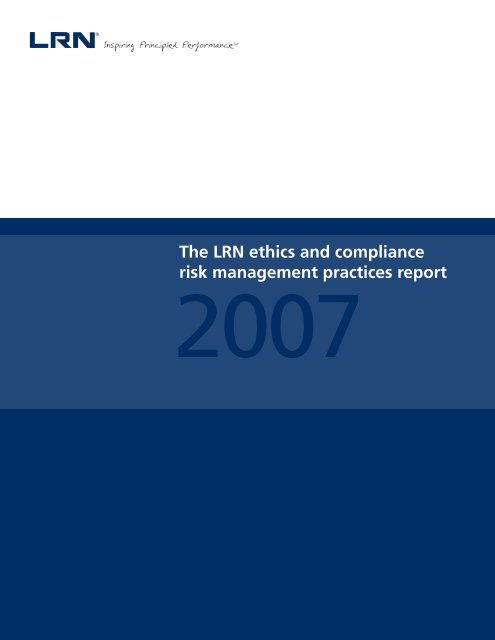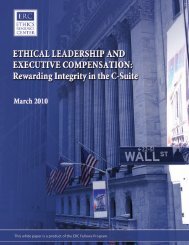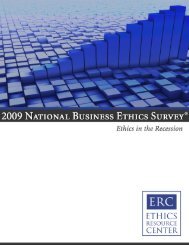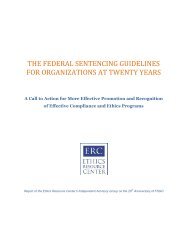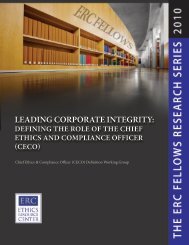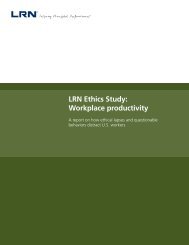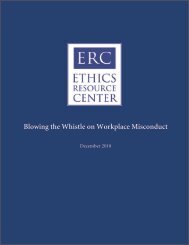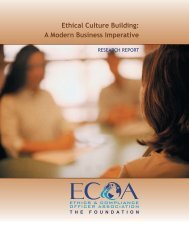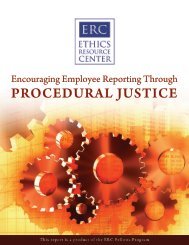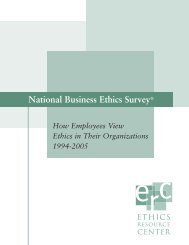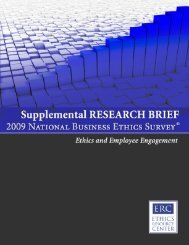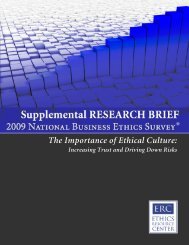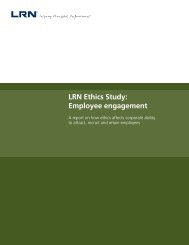LRN - Risk management Survey - Ethics Resource Center
LRN - Risk management Survey - Ethics Resource Center
LRN - Risk management Survey - Ethics Resource Center
- No tags were found...
Create successful ePaper yourself
Turn your PDF publications into a flip-book with our unique Google optimized e-Paper software.
The <strong>LRN</strong> ethics and compliancerisk <strong>management</strong> practices report2007
Table of Contents1 Introduction4 Key findings6 Detailed results6 Defining ethics and compliance risks13 Preventing ethics and compliance risks19 Detecting ethics and compliance violations23 Responding to reported ethics and compliance violations26 Evaluating the ethics and compliance process32 Discussion36 Final perspective36 For further studyThe <strong>LRN</strong> ethics and compliancerisk <strong>management</strong> practices report2007
introductionMore than ever before, companies must advance business culturesthat value legal and ethical business conduct. Regulators, investors,business stakeholders and the public are increasing their demandsfor companies to conduct business with integrity, honesty and trust.Growing data demonstrate a link between ethical business culturesand corporate success, indicating that companies that operate withhigh standards of legal compliance and ethical conduct can enhancecustomer loyalty, build investor confidence and strengthen employeerecruitment and retention.Increasingly, nurturing a strong corporate culture is recognized as a key element inmanaging ethics and compliance risk. To be effective, however, ethics and compliancerisk <strong>management</strong> requires a systematic, holistic approach. Companies must implementintegrated risk <strong>management</strong> processes that work together in complementary fashionto define and identify risks, educate workers, detect violations, conduct investigationsand continually fortify the corporate culture.In the past decade – and especially since the revised U.S. Federal Sentencing Guidelines– companies have put in place a wide range of ethics and compliance risk <strong>management</strong>practices. In an effort to measure how widespread risk <strong>management</strong> efforts havebecome, which practices are most commonly followed, and whether companies aretruly moving toward an integrated, systematic process, <strong>LRN</strong> conducted a survey of seniorpersonnel from ethics and compliance, legal, risk and audit departments.This report presents the results of the <strong>LRN</strong> survey and analyzes the data forpatterns and trends. The findings can help ethics and compliance professionals gainvaluable insight into how others are managing their ethics and compliance risks.Comparing practices employed in other organizations can help ethics and complianceprofessionals benchmark their own programs, assess their overall effectiveness andtarget improvements. In addition, companies with operations outside the United Stateswill find the results useful in contrasting their practices at headquarters with thoseat international operations.The <strong>LRN</strong> survey found numerous challenges still remain in implementing effective ethicsand compliance risk <strong>management</strong> programs. The discussion section at the end of thisreport highlights those challenges and proposes solutions that ethics and complianceprofessionals can integrate into their efforts to improve risk <strong>management</strong> and advancetheir goal of developing strong ethical business cultures.The <strong>LRN</strong> ethics and compliance risk <strong>management</strong> survey will be conducted annually andbroadened to provide regular comparison of ethics and compliance practices and to chartprogress over time.<strong>LRN</strong> | ETHICS AND COMPLIANCE RISK MANAGEMENT PRACTICES REPORT |
introductionRespondent profileTitle and role of respondentsAll respondents had senior titles in one of the following fields: ethics, compliance,legal, risk or audit. Sixty-four percent of respondents had primary responsibility for theirorganizational ethics and compliance initiatives.Size of companies<strong>Survey</strong> respondents represented companies ranging in size from a few thousandemployees to more than 10,000. The majority of respondents, 54 percent, were fromlarge companies with more than 10,000 employees.Company size by number of employeesunder 5,00021%5,000 – 10,00025%10,000+54%Location of headquarters and presence in global regionsThe majority of respondent companies (90 percent) were headquartered in the UnitedStates, with others headquartered in Canada, Europe, Asia/Pacific and Africa. Nearlytwo-thirds of respondents had operations in multiple (two to seven) regions of the world.Breakdown of companies according to number of regions of operationLocal only24%7 regions26%2 regions11%3 regions8%6 regions9% 5 regions4 regions14%8%<strong>LRN</strong> | ETHICS AND COMPLIANCE RISK MANAGEMENT PRACTICES REPORT |
introductionThe table below shows a breakdown of the number of regions of operation amongrespondents according to the location of their headquarters.Number of regions of operationLocation of headquarters 1 2 3 4 5 6 7US 38 15 12 13 19 12 36Canada 0 0 0 0 1 1 0Europe 1 1 1 0 2 1 5Asia/Pacific 0 1 0 0 0 0 1Africa 0 0 0 0 0 0 1*No respondents were headquartered in the Middle East or South America/Central America/Caribbean.Industries representedThe survey participants represented organizations from a broad range of industries, including:• Aerospace and defense• Agriculture• Banking• Chemical• Communications, media• Consumer products and electronics• Energy, power, oil and gas• Financial services• Government• Healthcare• Information technology and technology services• Insurance• Manufacturing• Pharmaceuticals• Retail• Transportation<strong>Survey</strong> methodologyConducted in October–November 2006, <strong>LRN</strong> e-mailed an invitation to complete thesurvey to 1,839 senior ethics, compliance, legal, risk and audit professionals, of which161 completed the survey. The survey was completely anonymous and each respondentcould take the survey only once. (A possibility exists that there might be multipleresponses from one company, though <strong>LRN</strong> estimates this number to be extremely limited).The survey questionnaire included multiple choice questions developed in collaborationwith experts in the ethics and compliance risk assessment field.Significance has been analyzed using the chi-square statistics. The threshold forreporting differences or relationships as statistically significant is: p < 0.05. Thissurvey was self-administrated using the Instant <strong>Survey</strong> online tool from GMI (GlobalMarket Insite, Inc.). Rounding may occasionally cause some total results to add upto greater than 100 percent.<strong>LRN</strong> | ETHICS AND COMPLIANCE RISK MANAGEMENT PRACTICES REPORT |
key findings1. <strong>Ethics</strong> and compliance risk assessments are sometimes integrated withother company risk assessments, but the majority of companies do notinvolve their executives and business managers in the risk assessment.About half of the surveyed companies integrate their ethics and compliance riskassessments with other business risk assessments. However, in the risk assessmentprocess, only 42 percent obtain input from their executives and only 37 percentobtain input from their business managers.2. Companies regularly report the results of their ethics and compliance riskassessment and the evaluations of their prevention programs to seniorleadership, but lag in reporting to operational managers.Most companies (80 percent) share the findings from the risk assessment processwith their top executives. Almost all companies (95 percent) make relatively frequentreports on the progress of their ethics and compliance education programsto their senior executives and board. However, they involve <strong>management</strong> far lessfrequently, with only half of companies (51 percent) sharing the risk assessmentresults with business managers.3. Most companies have multiple functions collaborate in the ethics andcompliance risk assessment process and in investigating violations.More than three-quarters of companies involve the legal department in performingethics and compliance risk assessments and in investigating reports of incidentsand potential violations. Two-thirds of companies involve internal audit in assessmentsand investigations. Close collaboration between the legal, internal audit and/orcompliance department in the risk assessment process is also highly common.4. Companies offer a wide range of risk prevention programs such as onlineeducation and certifications, but programs are consistently less robustat international locations than at headquarters.Companies with international operations employ a spectrum of preventionprograms (e.g., online or on-site education, certification and performance reviews).The most common prevention effort is a code of conduct, offered by all respondents(100 percent) at their headquarters operation. However, reported results for everytype of prevention program are consistently lower for companies’ internationallocations than for their headquarters.5. Many companies still express concerns that employees fear retaliation forreporting incidents, despite the prevalence of anonymous reporting technologies.Almost all (98 percent) respondents offer an anonymous phone line or a confidentialreporting channel. However, almost two-fifths (39 percent) of companies believe theiremployees still fear retaliation for reporting.<strong>LRN</strong> | ETHICS AND COMPLIANCE RISK MANAGEMENT PRACTICES REPORT |
key findings6. Detecting ethics and compliance violations presents a significantchallenge for companies.About three-quarters of companies report significant difficulty in detectingethics and compliance violations, both in their home markets (67 percent) andin their international operations (73 percent). The reasons cited include employeesfearing retaliation by the company, feeling unmotivated or failing to understandcompany policies.7. Many companies are confident in their ability to conduct effectiveinvestigations.Conducting investigations received the highest percentage of companies (32 percent)reporting no significant challenges compared to other risk <strong>management</strong> processes,perhaps because companies have greater experience in investigating than in defining,preventing, and detecting ethics and compliance risks. However, the remainingrespondents cite a range of challenges, including lack of resources and a scarcityof qualified investigators. Companies with operations in multiple regions also citedproblems investigating incidents occurring at international locations.8. Compliance professionals frequently cite a lack of resources (budget andstaff) as their leading risk <strong>management</strong> challenge.About half of ethics and compliance officials named inadequate resources as theirbiggest challenge in conducting the risk assessment (49 percent) and in implementingprevention programs (53 percent). Lack of adequate resources was also cited as thesecond biggest challenge in investigating allegations.9. Companies attempt to accurately evaluate the effectiveness of their ethicsand compliance programs and use the data to improve their programs.A majority of companies use qualitative (63 percent) or quantitative (52 percent)measures to evaluate the impact of their ethics and compliance process, and47 percent use internal program/process audits. With the data collected, 82 percentof companies attempt to improve their process.10. Despite the prevalence of strong program evaluation efforts, somecompanies find the interpretation, analysis and application of the datacollected challenging.Even with the above qualitative and quantitative evaluations, many companiescite challenges in correlating the data captured to results (38 percent), as well ascorrelating the results to business improvements (33 percent) and aggregatingand analyzing data (29 percent) across programs.<strong>LRN</strong> | ETHICS AND COMPLIANCE RISK MANAGEMENT PRACTICES REPORT |
detailed resultsDefining ethics and compliance risks1. Is your ethics and compliance risk assessment process integratedwith other risk assessment processes within the enterprise?<strong>Ethics</strong> and compliance risk assessmentIntegration with other risk assessment processesIntegrated52%Not integrated32%Do not perform12%Don’t know5%84 percent of companies surveyed conducted an ethics and compliance risk assessment,either as a stand-alone process or as part of other risk assessment processes within the enterprise.The majority – 52 percent – reported integrating the ethics and compliance risk assessmentwith other risk assessment processes, but a significant minority – 32 percent – conducted the ethicsand compliance assessment as a stand-alone process. Only 12 percent of respondentssaid their companies did not perform an ethics and compliance risk assessment, while theremaining five percent did not know whether or not their company conducted such an assessment.Most companies perform ethics and compliance assessments anda slim majority integrate them with other business risk assessmentsin the company.Historically, ethics and compliance officers were viewed as specialists in respondingto allegations of wrongdoing. However, this narrow view of ethics and complianceis changing. A substantial majority of companies performs an ethics and compliance riskassessment, and a slim majority now recognizes the value of integrating ethics andcompliance risk assessments with other risk assessment processes. Integration helps deepenthe company’s understanding of the risks it faces, allowing more effective preventiontechniques. Existing risk assessments also tend to overlap in some areas with ethics andcompliance, so integration creates a more efficient process.<strong>LRN</strong> | ETHICS AND COMPLIANCE RISK MANAGEMENT PRACTICES REPORT |
detailed results2. What types of ethics and compliance risks does your companyexamine as part of its risk assessment process?Types of ethics and compliance risks examined in multinational companies% Headquarters % InternationalCompany policy complianceLegal complianceRegulatory complianceEthical/reputation risksFinancial complianceInformation technology complianceEnvironment/health/safety complianceEmployment complianceSupply chain/sourcing compliance67%66%83%83%80%66%60%57%78%74%70%53%51%48%48%36%68%67%Among companies with multinational operations, approximately three-fifths of respondentsreported examining company policy (83 percent), legal (83 percent) and regulatory (80 percent)compliance at their headquarters location. About three-quarters of respondents also reportedincluding ethical/reputational risks (78 percent) and financial compliance (74 percent). Fewerrespondents cited examining information technology compliance (70 percent), environmental/health/safety compliance (68 percent), or employment compliance (67 percent) in theirhome location.In their international regions, companies reported examining risks to lesser degrees, but riskassessments remain grouped into the same three tiers of priority. Company policy (67 percent),legal (66 percent) and regulatory (66 percent) compliance are most often included in anassessment, followed by ethics/reputation (60 percent), financial (57 percent) and IT (53 percent),and finally by environment/health/safety (51 percent) and employment issues (48 percent).In both headquarters and international regions, supply chain/sourcing compliance was theleast assessed category of risk. A little less than half of respondents (48 percent) reportedexamining supply chain compliance in their home markets, while only 36 percent did soin international regions.<strong>LRN</strong> | ETHICS AND COMPLIANCE RISK MANAGEMENT PRACTICES REPORT |
detailed resultsU.S. companies examine a broad array of ethics and compliance risksat home but are less comprehensive in their operations abroad.Given that 88 percent of the multinational participants worked in companiesheadquartered in the United States, this result generally reflects practices at U.S.-based companies with international operations. The reduced levels of risk assessmentinternationally may reflect cultural and legal differences that act as obstacles toimplementing U.S. standards and guidelines abroad. Decentralized ethics andcompliance functions that are not able to coordinate well across international bordersmay be another barrier to consistent international practices.Across all regions, supply chain/sourcing compliance received the least amount ofattention from ethics and compliance risk assessments. More than half did not examinethem at home, while even more – about two-thirds of respondents – did not examinethese issues in their foreign regions of operation. The apparent low interest in the supplychain risk assessment may reflect the inherent difficulties of balancing the independenceof suppliers with the enforcement of mutual standards. Suppliers based entirely in aforeign country, for example, may be under no legal obligation to follow the standardsof their customers, nor have the appropriate systems or procedures in place to meetthem voluntarily. However, the risks of supply chain/sourcing channels are equally criticalfor companies to consider.Despite these challenges, separate research by <strong>LRN</strong>, combined with the fact that justover half of respondents are considering supply chain compliance, suggests that there isan upward trend in ethics and compliance toward assessing risk throughout theextended enterprise. 1 Such a trend may reflect the influence of the U.S. FederalSentencing Guidelines which counsel large organizations to “encourage smallorganizations (especially those that have, or seek to have, a business relationship withthe large organization) to implement effective compliance and ethics programs.” 21. Source: <strong>LRN</strong> client community interviews, conducted during the week of October 3, 2005.2. Source: “2005 Federal Sentencing Guidelines Manual and Appendices” (United States SentencingCommission, effective 1 November 2005) http://www.ussc.gov/guidelin.htm.<strong>LRN</strong> | ETHICS AND COMPLIANCE RISK MANAGEMENT PRACTICES REPORT |
detailed results3. Who is involved in performing your ethics and compliancerisk assessment?Departments involved in ethics and compliance risk assessment78%73%66%43% 42%42%37%35%28%15%14%11%4%Legal departmentCompliance officeInternal auditFinance functionHuman resourcesExecutive teamBusiness managers<strong>Ethics</strong> office<strong>Risk</strong> officeBoard of directorsExternal auditorsOutside consultantsOtherA solid majority of companies surveyed involved the legal department (78 percent), complianceoffice (73 percent) and internal audit (66 percent) in performing ethics and compliance riskassessments. A minority of respondents reported that either the risk office (28 percent) or thebusiness managers (37 percent) took part in performing assessments.The executive team, human resources and finance function were also sometimes involved, with43 percent of respondents involving finance and 42 percent partnering with executives orpersonnel from human resources. However, boards of directors as well as external auditors andconsultants were rarely participants in performing ethics and compliance risk evaluations. Only15 percent of respondents reported involvement by the board of directors, 14 percent involvedexternal auditors, and just 11 percent looked to outside consultants.Despite their proximity to operations, business managersare often not involved in risk assessments.Integrating business managers into the risk assessment process appears to be lagging.The fact that little more than one-third of respondents reported involvement ofbusiness managers suggests that integration of the risk assessment process down tothe business unit level may not yet be a recognized practice. However, businessmanagers are closest to the day-to-day operations of the company and often have thegreatest knowledge of potential risks. Including business managers in risk assessmentswould likely strengthen the process.Otherwise, companies generally reported involving multiple departments in assessments– as shown in the following table – often using a combination of legal and compliance orinternal audit. A significant number of respondents reported using teams composed of all<strong>LRN</strong> | ETHICS AND COMPLIANCE RISK MANAGEMENT PRACTICES REPORT |
detailed resultsthree departments: compliance, legal and internal audit. Legal’s involvement likelyreflects the fact that ethics and compliance are so often a part of the legal function.Departments involved in ethics and compliance Responses % Totalrisk assessmentLegal and compliance 85 60%Legal and internal audit 79 56%Compliance and internal audit 67 47%Compliance and legal and internal audit 59 42%Totals among companies that assess ethics 142 100%and compliance risk4. How often do you conduct your ethics and compliancerisk assessments?Frequency of conducting compliance risks assessments46%19%15%9%6%4%AnnuallyPeriodic,part of auditNo formal orset scheduleMore thanonce a yearLess thanonce a yearDon’t knowA combined total of more than 50 percent of companies surveyed conducted ethics andcompliance risk assessments either annually (46 percent) or more than once a year (9 percent).Only 6 percent performed the assessment less than once a year, and 15 percent followed no setschedule at all. A further 19 percent tied the evaluation process to financial auditing, which mayoccur annually or less frequently, depending on the status of the company (public vs. private)and applicable accounting standards.Performing an annual risk assessment is the most common practice.Companies appear to practice risk assessments on a regular, consistent basis.<strong>LRN</strong> | ETHICS AND COMPLIANCE RISK MANAGEMENT PRACTICES REPORT | 10
detailed results5. How do you use or apply information from your ethics andcompliance risk assessment?Using ethics and compliance risk assessment findingsShare findings with:Employees15%Board and/orsenior executives80%Managers51%Companies usually shared the findings of their ethics and compliance risk assessment withtheir board of directors and senior executives. Among respondents, 80 percent reported thatassessment results were communicated to the board and/or senior executives. In contrast,51 percent shared results with managers; only 15 percent of the companies released resultsto employees.Using ethics and compliance risk assessment findingsRank findings according to:Map risks to:Other metrics29%Other metrics12%Probabilityof occurrence51%Monetary value42%Specific employeesor groups26%Using information gathered in risk assessments to either rank or map risks was less common thansharing results. A little more than half of respondents (51 percent) said their company rankedethics and compliance risks by probability of occurrence. Fewer companies (42 percent) reportedranking risks according to their monetary value; the smallest percentage (29 percent) rankedby other metrics. The percentages for mapping risks to specific employees or groups (26 percent)and to other metrics (12 percent) were even lower.<strong>LRN</strong> | ETHICS AND COMPLIANCE RISK MANAGEMENT PRACTICES REPORT | 11
detailed resultsRanking and mapping risks are not yet common practices.Almost half of respondents do not apply any type of ranking methodology to the risksuncovered in their assessments. Ranking is a useful practice because it not only identifiespossible immediate trouble spots but helps ensure that education curriculums and otherprevention techniques are targeted at the risks most likely to occur or those with thepotential for greatest impact. The current difficulty of mapping risks to specific employeesor groups may explain why it is even less implemented than ranking. One reason is thatHR systems are typically not equipped to capture activities associated with specific risks.However, leading companies are increasingly using automated tools that allow them tosurvey employees to capture responsibilities and map risks in a bottom-up fashion.The popularity of sharing findings with boards and senior executives is understandable,given that government regulations place ethics and compliance responsibilities onthese officers. Looking back at who is involved in conducting assessments (16 percentof boards, 42 percent of executive teams, 37 percent of business managers), andwhen assessments are conducted (46 percent annually, 9 percent more than once peryear), it might be concluded that most boards see only the annual results of assessmentswhile a solid majority of executives see more regular updates even though they arenot engaged in guiding the assessment process in a significant way.6. What are the biggest challenges you face in conducting yourethics and compliance risk assessment?Challenges in assessing ethics and compliance risksInadequate resources (staff/budget)Obtaining accurate and quantifiable informationDifficulty in conducting a global assessmentAnalyzing and applying the findingsInsufficient technologyNo significant challengesOtherDon’t know19%18%12%8%10%40%34%49%According to nearly half of respondents (49 percent), a lack of resources was the biggestchallenge they face in conducting ethics and compliance risk assessments. Forty percent ofrespondents were also concerned about obtaining accurate and quantifiable information.Approximately one-third (34 percent) reported difficulties in conducting global assessments.Two other challenges were less commonly cited; only 19 percent of respondents viewedanalyzing and applying findings as a significant challenge, and only 18 percent believed theyneeded additional technology.<strong>LRN</strong> | ETHICS AND COMPLIANCE RISK MANAGEMENT PRACTICES REPORT | 12
detailed resultsConstrained resources and collecting accurate data challengerisk assessments.Lack of adequate resources was cited as the leading challenge in conducting riskassessments. One solution to this reality is for the ethics and compliance function toreach out to other functions in the organization in order to establish a wider base ofleaders and business managers who can champion the importance of the risk assessmentand help the process gain support, momentum and assistance.The second leading challenge, obtaining accurate and quantifiable information, pointsto the need for companies to enhance their use of automated systems to collect ethicsand compliance risk assessment data (versus paper-based methods that many companiesare still using). As companies increasingly turn to advanced analytics and metrics,automated systems will aid greatly in capturing accurate and quantifiable informationthat can drive the risk assessment process.The third most commonly cited challenge is conducting global evaluations. This responsemay help explain the earlier finding that fewer types of risk assessments are done in theforeign operations of most companies compared with their headquarters.Preventing ethics and compliance risks7. What activities or programs does the company have in place toeducate and/or certify employees in specific ethics and compliancerisks at the headquarters and in international regions?Activities and programs to educate or certify employeesActivities/programs in place to educate/certify employeesin ethics and compliance risksHeadquarters InternationalCode of conduct/ethics 100% 86%Internal communications efforts 90% 77%Online education 88% 70%Electronic certifications/attestations 81% 64%In-person education 76% 63%Formal CEO/senior mgmt involvement 67% 56%Written certifications/attestations 62% 57%Management/leadership development 56% 46%Site visits 57% 48%Employee performance reviews/other incentives 51% 38%No formal programs in place 7% 7%Other 3% 2%Among respondents with multinational operations, a first tier of prevention stood out,including the use of a code of conduct (100 percent locally, 86 percent internationally), internalcommunications (90 percent locally, 77 percent internationally), and online education(88 percent locally, 70 percent internationally).<strong>LRN</strong> | ETHICS AND COMPLIANCE RISK MANAGEMENT PRACTICES REPORT | 13
detailed resultsThe next tier of prevention methods included electronic certifications (81 percent locally, 64percent internationally) and in-person education (76 percent locally, 63 percent internationally).The following activities were less commonly implemented: formal involvement of the CEOand senior <strong>management</strong> (67 percent locally, 56 percent internationally), written certificationsor attestations (62 percent locally, 57 percent internationally), <strong>management</strong> and leadershipdevelopment (56 percent locally, 46 percent internationally), site visits (57 percent locally,48 percent internationally), and employee performance reviews and other incentives (51 percentlocally, and 38 percent internationally). Only 7 percent of respondents said their companieshad no formal education or certification programs in place.Most companies approach prevention using a variety of means, thoughheadquarters locations consistently report higher levels of preventionactivities than international locations.The high percentage of respondents who cite education activities both locallyand internationally demonstrates a positive trend toward using multiple means ofrisk prevention.Certain types of prevention activities are less frequently implemented, perhaps becausethey require greater investment, personalization or resources, such as <strong>management</strong>/leadership development and site visits. Of particular note is the lesser emphasis placedon two types of <strong>management</strong> activities: formal CEO/senior <strong>management</strong> involvement(67 percent locally, 56 percent internationally) and <strong>management</strong>/leadership development(56 percent locally, 46 percent internationally). This result is deserving of further studygiven how important <strong>management</strong> education can be in prevention and in communicatingthe importance of prevention to frontline employees. Likewise, incorporating ethicsissues into employee performance reviews is an effective way for companies to link theirrisk concerns with employee behavior.The findings also point out that companies do not yet offer the same scope ofprevention methods in their international locations. Causes may reflect the challengeof deploying efforts globally (e.g., translating education and certification programsinto preferred languages, identifying culturally relevant experiences, and reaching adispersed workforce).<strong>LRN</strong> | ETHICS AND COMPLIANCE RISK MANAGEMENT PRACTICES REPORT | 14
detailed results8. To which non-employee groups do you provide the ethics andcompliance education and/or certification activities/programs?<strong>Ethics</strong> and compliance educational programsWho multinational companies reach% Headquarters % International96%84%96%83%70%60% 55%27%42%27% 20%14%3% 2%Supervisors/managersSenior executivesSubsidiariesBoard of directorsOffline employeesPartners/suppliersOtherAmong companies with multinational operations, the groups most targeted by ethics andcompliance programs in home markets include: supervisors and managers (96 percent), seniorexecutives (96 percent) and subsidiaries (70 percent). The top three international targets werethe same, though the percentages were slightly lower. In international regions, 84 percent ofrespondents reported targeting supervisors and managers, 83 percent provided education tosenior executives, and 60 percent educated or certified subsidiaries.Respondents were least likely to provide education and certification programs to boards of directors(55 percent locally, 27 percent internationally), offline employees (42 percent locally, 27 percentinternationally), and partners and suppliers (20 percent internationally, and 14 percent locally).Almost all executives and managers are being reached by ethics andcompliance education efforts.Regulations requiring that companies encourage an ethical corporate culture andestablish effective compliance programs have clearly inspired leadership to consistentlyinfuse ethics and compliance education throughout the organization. Somewhatsurprising, however, is the lesser degree to which board members receive education,given the U.S. Federal Sentencing Guidelines, which assign ultimate responsibility to theboard. Board education is an area to watch for future development.<strong>LRN</strong> | ETHICS AND COMPLIANCE RISK MANAGEMENT PRACTICES REPORT | 15
detailed resultsMeanwhile, suppliers and partners are the least targeted groups for education. Theyare likely to become important elements of effective ethics and compliance educationin the future for two reasons. First, the U.S. Federal Sentencing Guidelines suggest thatlarge organizations encourage smaller partners to “implement effective complianceand ethics programs.” Second, the public doesn’t differentiate between the actions ofa company and those of its suppliers and partners, expecting ethical business conductfrom both.9. How many employees do you reach with your ethics and complianceeducation and/or certification activities/programs?US Canada/ Europe South Asia/ Africa MiddleMexico America/ Pacific EastCaribbeanAll employees 65% 56% 49% 45% 47% 40% 40%Most employees 27% 31% 37% 28% 28% 31% 29%Some employees 8% 11% 12% 25% 25% 25% 29%No employees 0% 2% 1% 3% 0% 4% 2%Responses reflect answers only for those companies doing business in each region.• In the U.S., a combined total of 92 percent reported reaching all (65 percent) or most(27 percent) of their employees with ethics and compliance education.• In Canada and Mexico, 87 percent reported reaching all (56 percent) or most (31 percent)of their employees, while 11 percent reported reaching only some employees.• In Europe, 86 percent believed all (49 percent) or most (37 percent) employees participatedin education or certification programs, while 12 percent reported some participation.• In South American and the Caribbean, 73 percent of respondents reported that programssuccessfully included all (45 percent) or most (28 percent) employees, while 25 percentof companies believed their programs included some employees.• In Asia/Pacific regions, a slightly higher percentage of respondents (75 percent) believed all(47 percent) or most (28 percent) employees were being reached by education or certification,while one-quarter of respondents believed only some employees were being reached.• In Africa, 71 percent reported reaching all (40 percent) or most (31 percent) employees,and one-quarter reported reaching some employees.• In the Middle East, 40 percent of respondents reported reaching all employees, while 29 percentreported reaching most, making the combined percentage for the Middle East slightly lowerthan Africa’s and the lowest of all. The Middle East also had the highest percentage of ethicsand compliance education that reached only some employees – 29 percent.<strong>LRN</strong> | ETHICS AND COMPLIANCE RISK MANAGEMENT PRACTICES REPORT | 16
detailed resultsAcross the world, companies reach all or most of their employeeswith their education or certification programs.In every region, about 70 percent of companies reach all or most of their employees.This accomplishment is achieved despite the significant number of workers that can bedifficult to reach in certain industries surveyed such as agriculture, energy, manufacturing,retail, transportation and sales where workers spend the majority of their time in the“field,” without either ready access to an Internet kiosk or a setting in which to completeonline ethics and compliance education.10. How often do you report to senior executives or the boardon your ethics and compliance education and/or certificationactivities/programs?Reporting on ethics and compliance education programsNo reporting1%I do not know4%On anongoing basis20%Annually37%Quarterly38%Almost all of respondents (95 percent) reported to senior executives or the board of directors abouttheir ethics and compliance education and certification activities. Among these, 38 percent said theyreport on a quarterly basis, 37 percent report annually and 20 percent provide ongoing updates.Quarterly and ongoing reporting on education efforts are morecommon practices than annual reporting.Increased liabilities for ethics and compliance violations have made the progress of ethicsand compliance prevention programs an important issue for executives and directors. As aresult, the majority of companies (58 percent) expect progress reports more frequentlythan annually, either quarterly or ongoing. In future studies, <strong>LRN</strong> will continue to studythis area for further changes to the frequency and importance of reporting.<strong>LRN</strong> | ETHICS AND COMPLIANCE RISK MANAGEMENT PRACTICES REPORT | 17
detailed results11. What are the biggest challenges you face in providing ethics andcompliance education and/or certification activities/programs?Challenges in providing ethics and compliance education programsInadequate resourcesCultural differences globallyRegulatory differencesLack of translated E/C materialsTechnology constraintsKnowing all our compliance risksLack of E/C materials26%22%22%21%34%37%53%Low employee engagement21%Union objections14%Low <strong>management</strong> support11%No significant challengesOther7%9%Don’t know2%The top challenges in providing ethics and compliance education included a lack of adequateresources, cultural and regulatory differences in international operations, and translating.More than half of respondents (53 percent) cited inadequate resources, 37 percent named globalcultural differences, and 34 percent referenced regulatory differences. More than one-quarter(26 percent) of companies had difficulty translating materials into foreign languages.Four additional challenges nearly tied in frequency: technology constraints (22 percent), knowingall the compliance risks on which to educate (22 percent), lack of education and/or certificationmaterials in some risk areas (21 percent), and low engagement and interest on the part ofemployees (21 percent).The least frequently cited challenges were union objections (14 percent) and a low level of supportfrom <strong>management</strong> (11 percent). Only 9 percent of companies reported no significant challengesin deploying ethics and compliance education and certification programs.Inadequate staffs and budgets lead the challenges to educationand certification programs, followed by various globalization andtranslation issues. However, union objections present few problems.About one in two respondents believe they do not have enough resources to supporttheir ethics and compliance education and certification programs. This result mayexplain in part why certain types of programs such as <strong>management</strong>/leadership developmentand site visits are implemented less frequently. Again, this finding points to the need for theethics and compliance function to reach out to other departments within the organizationto enlist greater resources and support for quality prevention programs.<strong>LRN</strong> | ETHICS AND COMPLIANCE RISK MANAGEMENT PRACTICES REPORT | 18
detailed resultsThe numerous additional challenges cited lagged far behind the resources issue. However,several of them reflect the globalization challenge, including cultural and regulatorydifferences as well as translations of ethics and compliance materials. Not surprisingly,companies that cited cultural differences as a challenge also generally had difficulties withregulatory differences and translating materials.One note of interest for those in unionized industries is that the figures for problemswith union objections are low. Comparatively few companies cited unions as one of theirbiggest challenges compared with the other difficulties.Detecting ethics and compliance violations12. What are the methods you provide for employees and othersto report ethics or compliance violations?Violation reporting methods in multinational companies% Headquarters % InternationalAnonymous/phone lineLegal departmentSupervisorHR<strong>Ethics</strong>, compliance orbusiness conduct officeInternal ombudsmanOther10%7%20%14%77%65%85%98%92%79%91%80%87%79%Nearly all companies with international operations (98 percent) provided employees in homeregions with a confidential channel, such as an anonymous phone line, to report ethics andcompliance violations. Most respondents (85 percent) also provideda confidential reporting channel in their international regions.Other avenues for reporting ethics and compliance violations that were commonly providedin home markets were the legal department (92 percent), a supervisor (91 percent), humanresources (87 percent), and an office of ethics and compliance or business conduct (77 percent).But fewer respondents indicated their international operations sought reporting through asupervisor (80 percent), the legal department (79 percent), human resources (79 percent), or anoffice of ethics and compliance/business conduct (65 percent). By far the least popular methodof reporting offered to employees was the internal ombudsman, which 20 percent of companiesprovided at home and only 14 percent provided in foreign markets.<strong>LRN</strong> | ETHICS AND COMPLIANCE RISK MANAGEMENT PRACTICES REPORT | 19
detailed resultsNearly all companies use a combination of anonymous reportingand other methods to detect violations.Companies recognize that different reporting channels are valuable for different employeegroups and circumstances. In fact, 99 percent of respondents offered multiple waysfor employees to report potential ethics and compliance violations in the company’s homemarket. The median number of channels offered for reporting was five.Given the majority of participants are headquartered in the U.S., the most frequentpractice in the headquarters region is an anonymous/confidential phone line, as requiredby Sarbanes-Oxley.Meanwhile, a lower percentage of multinational companies indicate using each reportingchannel, although they too offer multiple systems with a median of four channels inplace. Because international jurisdictions can present challenges to ethics and complianceefforts, multinational companies must often create separate reporting systems with localtechnologies and personnel who speak the local languages in order to conform to locallaws. Even when such systems are in place, local cultural differences may discourage theuse of the system.13. To whom are employees expected to report an ethics or complianceviolation first?First means of reportingSupervisorNo set policyOtherAnonymous/phone line<strong>Ethics</strong>/compliance officeHRLegal deptInternal ombudsmanDon’t know6%6%4%3%0%6%24%22%37%The largest group of respondents (37 percent) said that employees reporting potential ethicsor compliance violations are expected to turn first to supervisors. Almost a quarter (24 percent)reported no set policy with regard to whom an employee should see first, while the third leadinganswer (22 percent) was “other.” Because respondents sometimes chose more than onemeans of reporting, the low percentages in the remaining categories – 6 percent for anonymousphone lines, 6 percent for compliance and ethics office, 4 percent for human resources, 3 percentfor the legal department, and 6 percent for “don’t know” – add up to more than 100 percent.<strong>LRN</strong> | ETHICS AND COMPLIANCE RISK MANAGEMENT PRACTICES REPORT | 20
detailed resultsCompanies often do not have a set practice regarding where employeesare expected to turn first to report ethics and compliance violations.Although turning to supervisors appears to be the leading answer, many respondentselected to write in the “other” box, and the majority of those written answers alsoreflected no set policy or preference. A common example was the write-in “All,” thuseffectively signifying that no set policy truly existed. In this sense, the combinedpercentage of Other and No set policy (46 percent) suggests that the most commonpractice among companies is not to have a firm policy about reporting. Still, companiesmust understand which methods are being used (e.g., supervisors, helpline function)and devise education and awareness programs accordingly. For example, if employeesare to report first to supervisors, companies must educate supervisors on how to handleallegations effectively and in confidence, as well as educate employees about when tocall the helpline if they cannot resolve an issue with their supervisor. On the other hand,if employees are to use the helpline first, companies must be sure to have qualifiedpersonnel to answer the lines and refer allegations to the appropriate function.One point of interest here is that, despite the proliferation of anonymous/confidentialhelplines, supervisors remain the most popular first choice for reporting, possibly reflectingtheir role as the first line of defense. Given this, however, it is vital that supervisors beeducated on how to respond appropriately when their direct reports come to them withinformation.14. What are your biggest challenges in detecting ethics andcompliance violations?Challenges in detecting ethics and compliance violations in multinational companies% Headquarters % InternationalEmployees fear retaliationNo significant challengesInappropriate usesEmployees not motivatedEmployees don’t understandLack of formal <strong>management</strong> processInsufficient staff to respondOther10%7%6%5%4%2%16%14%15%33%27%28%26%28%39%39%<strong>LRN</strong> | ETHICS AND COMPLIANCE RISK MANAGEMENT PRACTICES REPORT | 21
detailed resultsAlmost four in 10 respondents with multinational operations believed their greatest challenge indetecting violations at both their local and international locations was employee fear of retaliation.More than a quarter of respondents were also concerned that both local (26 percent) andinternational (28 percent) employees were not motivated to report violations. Difficulties dealingwith inappropriate uses of reporting mechanisms at headquarters (28 percent) and regionallocations (16 percent) were the next most common responses.Three remaining categories of challenges were selected with less frequency: employees donot understand how to report (14 percent locally, 15 percent internationally); lack of a formal<strong>management</strong> process for detection (10 percent locally, 7 percent internationally); and insufficientstaff to respond (6 percent locally, 5 percent internationally). However, a third (33 percent)in home operations and a quarter (27 percent) in international locations reported not havingsignificant challenges in detecting risk.Employee fear of reporting still inhibits detection of violations, but moresignificant are issues relating to the improper use of reporting mechanismsand employee motivation and understanding.A potential whistleblower’s greatest fear is often company retaliation, and this fearremains an impediment to companies seeking reliable reporting of potential ethics andcompliance violations. The simple existence of anonymous reporting methods does notaddress the root causes of this fear, as shown by the fact that 98 percent of respondentsreported the use of anonymous reporting methods at headquarters (see above) but39 percent still cited fear of retaliation as their greatest challenge. (Ironically, in the <strong>LRN</strong><strong>Ethics</strong> study on workplace productivity, only 5 percent of employees themselves citedfear of retaliation as the reason they do not report suspected violations. In that study, thebiggest constraint for employees was their lack of trust that their employer would handletheir report correctly. Overall, theses contrasting results between the practices study andthe workplace productivity study suggest a breakdown in communication between ethicsand compliance managers and employees.)The greatest concerns relate to a lack of employee understanding and motivation.In headquarters operations, 28 percent of respondents believe that employeesinappropriately use reporting mechanisms, 26 percent say employees are not motivatedto report, and 14 percent indicate that employees do not understand how to report.Results on these three issues are almost as high for international operations as well.Combined, these numbers add up to two-thirds of companies that believe workremains in educating, motivating and instilling trust before employees will reportsuspected violations and self-govern at the level required to protect the company’sculture and reputation.<strong>LRN</strong> | ETHICS AND COMPLIANCE RISK MANAGEMENT PRACTICES REPORT | 22
detailed resultsResponding to reported ethics andcompliance violations15. Who typically is involved in investigations arising from reportsof violations?Departments involved in investigations arisingfrom reported violationsLegal departmentHuman resourcesInternal auditCompliance office<strong>Ethics</strong> officeOtherStanding committeeSpecial committee per allegationOutsource investigation processDo not conduct investigationsDon't know13%8%6%4%0%1%37%66%58%79%77%More than three-quarters of respondents reported involving the legal department (79 percent)and human resources (77 percent) while two-thirds (66 percent) involved internal auditin investigations that arose from reports of ethics and compliance violations. The next tierof involvement was either the compliance office (58 percent) or ethics office (37 percent).Only a small percentage of respondents employed a standing committee (8 percent) or specialcommittees (6 percent). Other methods are employed by 13 percent of other respondents.A very small proportion (4 percent) outsourced the investigative process.The most common investigating practice involves teaming legalwith the HR and/or internal audit departments.The high participation of legal and human resources departments in ethics andcompliance investigations is to be expected, given the nature of most allegationsand the potential legal impact they can have on a company. Two-thirds of respondentsreported the participation of internal audit in investigations. Beyond those singledepartment involvements, many companies employ a team approach, as the followingtable shows.<strong>LRN</strong> | ETHICS AND COMPLIANCE RISK MANAGEMENT PRACTICES REPORT | 23
detailed resultsDepartments involved% TotalLegal and internal audit 67%Legal and compliance 53%Compliance and internal audit 46%Compliance and legal andinternal audit 42%Using multiple departments reflects the fact that companies recognize that specialized expertiseis usually necessary to conduct investigations and that suspected violations can lead to manyrepercussions. In many ways, this team approach to ethics and compliance investigations parallelsthe cross-departmental approach of the assessment process.16. If one person typically leads your investigation, what is theperson’s job title?Key title to lead compliance investigationsNo single personCompliance top executivesGeneral counselInternal audit executive titles<strong>Ethics</strong> top titlesHR top titlesOther4%4%16%7%14%11%43%The largest share of respondents (43 percent) typically did not designate a single role tolead ethics and compliance investigations. The remainder of respondents designated a varietyof leaders, such as compliance top executives (14 percent), the general counsel (11 percent),internal audit executives (7 percent), and the top titles in the ethics (4 percent) and humanresources (4 percent) titles. Other roles within an organization were also tagged as leadinginvestigations in 16 percent of companies.Not having a single role head up an investigation is the mostcommon practice.Possibly in line with the previous question showing that a team approach is oftenused for investigations, nearly half of respondents appear not to designate a consistentleader to conduct their ethics and compliance investigations. This trend probably reflectsthat different investigations require different skills and knowledge. Relatively smallpercentages of companies appoint a single person, with the top three leaders beingeither a compliance executive, the general counsel or an internal audit executive.<strong>LRN</strong> | ETHICS AND COMPLIANCE RISK MANAGEMENT PRACTICES REPORT | 24
detailed results17. What are your biggest challenges in investigating allegations?Challenges in investigating allegationsNo significant challengesNot enough resources to conduct investigationsDifficulties in investigating incidentsoccurring at international locationsNot enough trained/qualified investigatorsNot enough training in how to conduct investigationsReluctance on the part of individuals/colleagues/managers to cooperateToo many false reportsOther32%26%19%16%16%15%10%9%Don’t know12%Of the companies surveyed, nearly one-third (32 percent) believe they did not face any challengesin investigating allegations of ethics and compliance violations. Of those who reported challenges,the major areas of concern were a lack of resources (26 percent), difficulties in investigatingincidents occurring at international locations (19 percent) and insufficient training or insufficientlytrained/qualified investigators (both 16 percent). Another 15 percent of respondents alsoreported reluctance on the part of people to cooperate in investigations.<strong>Resource</strong>s and lack of qualified people lead the challengesin investigating.Investigation processes have had longer to mature than other aspects of the ethicsand compliance function. As a result, the percentage of companies that report nosignificant challenges with investigations (32 percent) is far higher than the percentageof companies that cite no challenges in assessing ethics and compliance risks(12 percent) or preventing risks (11 percent).Nevertheless, a combined total of 58 percent of respondents believe issues relatingto either resources or to the education and knowledge of investigators are challenges.This is important for companies to heed given the critical nature of conductinginvestigations quickly with accuracy, fairness and legal aptitude.Two additional challenges are also worthy of note. First, nearly one in five (19 percent)believe that they experience difficulty conducting investigations in their internationaloperations. This finding is important for multinational companies, especially as they expandoperations to distant or culturally varied locations. Second, 15 percent of respondentscite the reluctance of people to cooperate. This result may reiterate the ideathat they lack the knowledge and education to do investigating, or it could point toother considerations such as lack of time. Whichever the cause, companies shouldbe sure that their employees have the knowledge, skills and commitment to become<strong>LRN</strong> | ETHICS AND COMPLIANCE RISK MANAGEMENT PRACTICES REPORT | 25
detailed resultsinvolved in investigations whenever their assistance is necessary. Here again, havingthe ethics and compliance function reach out to enlist resources and get the supportof other functions can help reduce or eliminate both these challenges.Evaluating the ethics and compliance process18. How do you formally evaluate the impact of your overall ethicsand compliance process?Evaluating the impact of the ethics and compliance processQuantitative measuresQualitative measuresInternal program / process auditsAnalysis of data correlated from all of our programsFormal assessment of our corporate cultureExternal program / process auditsWe do not evaluate our effortsOtherDo not know63%52%47%29%25%19%14%5%4%Companies most often used three approaches to measure the impact of ethics and complianceprograms. Among respondents, 63 percent reported using quantitative measures such asthe number and types of helpline calls. Another 52 percent employed qualitative measures,such as surveys of employee attitudes, and 47 percent relied on internal program and processaudits. Fewer, but still more than a quarter of respondents (29 percent), reported correlatingthe data across ethics and compliance programs. Exactly one-quarter of companies conductedformal assessments of corporate culture. External audits were the least popular method ofevaluating ethics and compliance programs; only 19 percent of respondents reported using them.Finally, 14 percent of companies did not evaluate the impact of ethics and compliance programs.The use of quantitative measures to assess the impact of ethicsand compliance programs is gaining ground.The majority of companies use quantitative measures to assess the effectiveness oftheir ethics and compliance programs, slightly more than qualitative or other measures.Further, companies use their internal resources rather than going outside to externalprogram or process audits. One item for further study is that only 29 percent ofcompanies say they correlate their collected data from their ethics and compliance riskassessments with data from other assessments in the company. However, integratingsuch other data might prove useful in strengthening the overall risk mitigation efforts.<strong>LRN</strong> | ETHICS AND COMPLIANCE RISK MANAGEMENT PRACTICES REPORT | 26
detailed resultsAlso notable is the finding that one-quarter of companies perform a formal assessmentof their corporate culture as a means to evaluate their programs. This methodologyis growing because it helps companies analyze and understand their corporate cultureon a more holistic basis, including risk assessment, work processes, employee attitudes,and many other factors that reflect the entire corporate character. This larger culturalevaluation will be a measure to track for a potential upward trend in future years. The U.S.Federal Sentencing Guidelines require companies to encourage an ethical culture, andit has become evident that doing so requires more than simply having programs in place.Companies must pay attention to and actively advance their entire culture if theyare truly to manage their ethics and compliance risks and enhance business performance.19. How often do you evaluate the impact of your overall ethics andcompliance process?Frequency of ethics and compliance process evaluationsOngoingOnce per yearOccasionally11%22%43%Never10%Quarterly5%Don’t know6%Forty-three percent of respondents reported evaluating ethics and compliance process onan ongoing basis. Only 22 percent perform a review annually, while 5 percent do quarterlyevaluations. About one in 10 companies (11 percent) reported doing only occasional evaluationswhile another one in 10 (10 percent) had no evaluations of the ethics and compliance process.Most companies evaluate their ethics and compliance process on anongoing basis or at least once per year.Seventy percent of the companies surveyed evaluate their ethics and compliance processat least annually, whether it is quarterly, ongoing, or once per year. An interestingcorrelation to other findings in this study is that the 48 percent of respondents reportingquarterly or ongoing evaluations is close to the 58 percent of respondents whoreport quarterly or on an ongoing basis to senior executives and board members abouteducation and certification progress. This suggests that a large share of companies ismaking an effort to monitor their progress in addressing risks on a fairly regular basis.<strong>LRN</strong> | ETHICS AND COMPLIANCE RISK MANAGEMENT PRACTICES REPORT | 27
detailed results20. What do you do with the information you derive from evaluatingyour overall ethics and compliance process?Applying ethics and compliance risk assessment findingsImprove our programsShare findings with board/senior <strong>management</strong>Share finding with the entire companyShare findings with outside stakeholdersOtherWe do nothingDon’t know6%8%6%9%22%82%80%Companies used their evaluations of the ethics and compliance process in two main ways:to improve their programs (82 percent) and to inform their senior <strong>management</strong> and board ofdirectors (80 percent). A small, but significant number of companies (22 percent) shared thefindings with the entire company, while sharing the findings with outside stakeholders (6 percent)was as unpopular as doing nothing with the information.Companies make use of the information they collect in evaluationsto improve their programs and to apprise their board and senior<strong>management</strong>.Evaluations are vital to help companies improve their ethics and compliance process byenabling better assessments, more targeted and deeper education and prevention programs,and more effective detection and investigation methods. Board members and seniorexecutives need data from the evaluations to understand more clearly what ethics andcompliance risk they face and how effectively their companies are mitigating thoserisks. Not surprisingly, boards and senior executives hear about program evaluations atthe same frequency level (80 percent) as reported in the risk assessment definition phase.One issue for further study is whether the trend will rise beyond the current 22 percentamong companies that share the ethics and compliance program evaluations with theirentire organization. Open, honest information can help engage and enlist employees,as it sends a strong signal that the company is truly serious about advancing a culture ofresponsibility and integrity.<strong>LRN</strong> | ETHICS AND COMPLIANCE RISK MANAGEMENT PRACTICES REPORT | 28
detailed results21. What are your biggest challenges in evaluating your overallethics and compliance process?Challenges of evaluating overall ethics and compliance processCorrelating data to resultsCorrelating results to business improvementsAggregating and analyzing the dataLack of adequate resourcesCollecting data about programs conductedin international regionsLack of adequate <strong>management</strong> tools/technologyEvaluating the ethics and compliance programCollecting data on programs conductedin headquartersOther38%33%29%26%22%15%14%13%8%Don’t know15%The top two challenges, cited by one-third or more respondents, were correlating data toresults (38 percent) and correlating results to business improvements (33%). An additional setof challenges hovered in the 20-30 percent range, including aggregating and analyzing thedata (29 percent), overcoming the lack of adequate resources in terms of staff and budget(26 percent), and collecting data about programs in international regions (22 percent).By comparison, only 13 percent felt challenged by collecting data about programs in theirheadquarters region. The final major challenge was a lack of adequate <strong>management</strong> toolsand technology (15 percent). A moderately sizable group of 15 percent said they did not knowwhat challenges they faced.Companies appear to be still struggling with collecting data andcorrelating it to results and business improvements.The challenge in ethics and compliance program evaluation is in the collection anduse of data, not resources (as it is for the assessment and education processes). Whetherit’s correlating what they learn to results, correlating results to business improvements,or aggregating and analyzing the data, companies are not reaping as much return fromtheir evaluation feedback as they could. Further study is required to understand thecauses of these impediments, assessing whether the wrong data is being collected orif more education is needed to make best use of data.As with other areas, global companies should take note of the fact that one in fivecompanies (22 percent) reported being challenged by collecting data in their internationalregions compared to a far lesser number (13 percent) having this challenge in theirheadquarters region. This probably results from a higher level of maturity in the systemsand processes used in headquarters.<strong>LRN</strong> | ETHICS AND COMPLIANCE RISK MANAGEMENT PRACTICES REPORT | 29
detailed resultsOverall self-assessment22. On a scale from 1–10, how would you rate your company’soverall capability to address and mitigate ethics and compliancerisks with accuracy and in a timely manner?Overall ethics and compliance process ratingAccuracyNo answer11%Below 611%9 and 1022%Below 621%No answer11%9 and 1011%6 to 856%6 to 854%HeadquartersInternationalTimelinessNo answer11%Below 613%9 and 1026%Below 624%No answer11%9 and 1015%6 to 850%6 to 846%HeadquartersInternationalCompanies with international operations rated their ethics and compliance performance roughlyequally for timeliness and accuracy in their headquarter region. The average rating for accuracyat headquarters was 7.7 and for timeliness was 7.6 (out of a scale of 10). In contrast, theirself-rating was at least a full point lower in evaluating effectiveness in their international regions,with an average rating of only 6.7 for both accuracy and timeliness.<strong>LRN</strong> | ETHICS AND COMPLIANCE RISK MANAGEMENT PRACTICES REPORT | 30
detailed resultsCompanies are moderately confident about their ethics and complianceeffectiveness in their headquarters regions, but less confident aboutperformance in international operations.Companies rate themselves as doing a moderately good job for the accuracy and timelinessof their risk <strong>management</strong> processes. This clearly reflects several years of build-up inthe deployment of risk assessments, prevention programs and investigation experience.It is understandable that companies gave themselves slightly lower average ratingsin their international operations. The gap in effectiveness clearly reflects the greaterchallenges companies face in implementing ethics and compliance across distances andamong culturally diverse workers. Numerous study findings reinforce that companiessee themselves as facing tougher challenges in their international programs, sohaving less confidence about their ability to manage risk in their foreign regions isunderstandable until those challenges are mastered.<strong>LRN</strong> | ETHICS AND COMPLIANCE RISK MANAGEMENT PRACTICES REPORT | 31
discussionThe <strong>LRN</strong> study demonstrates ethics and compliance professionals have establishedseveral robust ethics and compliance risk <strong>management</strong> practices, yet remained challengedto overcome issues in certain areas. Companies indicate that they integrate ethicsand compliance risk assessment into other corporate business risk assessment processes.Board members and C-suite executives are involved in ethics and compliance issues,regularly reviewing both evaluations of risk and educational programs. About half of theboard members at headquarters participate in education and certification programs,and almost all senior executives are educated or certified in ethics and compliance. Further,companies implement many methods of prevention, including codes of conduct, onlineand in-person education and electronic or written certifications. Companies are alsoskilled in conducting investigations. These accomplishments justify the moderately highrating respondents gave themselves for the accuracy and timeliness of their ethicsand compliance programs.However, the <strong>LRN</strong> study also shows that numerous key challenges remain, specifically:• A lack of resources in performing risk assessments, prevention and investigations.• Fear of retaliation and lack of employee motivation to report allegations.• Difficulty in implementing the same high level of ethics and compliance efforts inregional locations as achieved in headquarters.• Collecting accurate and quantifiable data about risks, aggregating compliance datafrom disparate operations and applying findings from their evaluation processesto business improvements.Companies may work toward resolving these challenges independently, such as byincreasing budgets, educating employees about reporting, engaging regional offices oncommon principles or purchasing better software to collect data. However, such singularefforts will not achieve the standards in ethics and compliance that companies need toensure effective risk <strong>management</strong>. Each of the four challenges actually reflects underlyingissues in the company’s ethics and compliance efforts and possibly in its culture.Following is a brief analysis of each challenge indicating the depth and breadth ofholistic efforts needed to address it.Addressing the lack of resources challengeWhile a lack of resources may reflect real budgetary or staffing issues, the root ofthe challenge lies in the corporate commitment to nurture a culture that values legaland ethical conduct. Beginning at the highest levels – the boardroom and C-suites –the organization must adopt the stance that how it conducts business matters.Company leadership and the ethics and compliance office need to work together todefine and communicate the company’s values regarding legal compliance and ethicalworkplace conduct.As this tone from the top disseminates throughout the organization, the ethics andcompliance office will be increasingly able to work around resource deficits. Improvementsin the risk <strong>management</strong> process will occur by virtue of strengthening the integrationof ethics and compliance into every department and function, involving line managersdirectly in the risk assessment process and reaching out to form supportive relationshipswith key executives and managers who encourage their direct reports to buy intothe importance of the company’s ethics and compliance prevention efforts.<strong>LRN</strong> | ETHICS AND COMPLIANCE RISK MANAGEMENT PRACTICES REPORT | 32
discussionThese strategies depend less on actual resources available than on tapping into theorganization’s commitment to make ethics and compliance both a priority and ahorizontal responsibility across all functions. By integrating ethics and compliance intothe fabric of the entire organization, the effort becomes a priori more systemic andrisk <strong>management</strong> gains in strength. Everyone – board members, leadership, managersand employees – becomes attuned to the importance of legal and ethical conductand engaged in supporting the company’s values.This approach also transforms the role of the ethics and compliance officer from oneof acting as the “corporate cop” who reacts to problems into “corporate coach”whose role is to teach and inspire others to higher standards of conduct. Operatingthe ethics and compliance function from this perspective also serves to mitigatebudgetary or staff resource limitations, given that the company now has its executives,managers and employees becoming stewards and protectors of the company’svalues, thereby moving the organization beyond mere compliance to true self-governance.Addressing the employee fear and lack of motivation to report challengeEmployee fears of retaliation and lack of motivation to report incidents also reflecta systemic problem in a company’s ethics and compliance program. In essence, fear andlack of motivation stem from a corporate culture that lacks trust. When employeesdon’t see or feel that their organization values ethical conduct or that reporting violationsand ethical lapses is worthwhile, they do not develop the internal belief system that theycan safely go to their <strong>management</strong> or an anonymous helpline to discuss ethical issues orreveal violations they witnessed.Eliminating employee fear and motivating them to safeguard their own culture mustultimately be approached through broad-based initiatives. Just as with lack of resources,the solution begins with a strong organizational commitment to fostering an ethicalculture. The company must establish firm policies about reporting and be transparent insharing them with employees. Employees must know in advance how <strong>management</strong>will handle and retain data, and how they will uphold confidentiality to protect individualswho report. It must also educate employees on how and when to report, what actionsqualify as reportable, how cases will be handled, and what procedures to follow whenusing the helpline or coming to a manager. Then, to lock in trust, employees must knowthat the company will respect and act on reports made. They must hear about or seeconcrete examples of how the company has taken quick action to respond fairly andconsistently to reports, without favoritism or exception.In short, turning fear and lack of motivation into trust and willingness to report involvesa holistic effort to infuse the entire corporate culture with the spirit of ethics andcompliance. As with resources, the true challenge is ultimately about transforming theorganization’s fundamental character from one in which employees acquiesce tocompliance to one in which employees seek to become self-governing through theirown commitment to safeguard the culture.<strong>LRN</strong> | ETHICS AND COMPLIANCE RISK MANAGEMENT PRACTICES REPORT | 33
discussionAddressing the global challengeThe <strong>LRN</strong> survey indicated that on nearly every issue where respondents contrastedtheir risk <strong>management</strong> processes at their home office with their international locations,the headquarters fared better. Here again, bringing a global organization’s ethicsand compliance programs to parity in all locations requires a holistic perspective andsystemic solutions.The company must declare that it has a common set of values and principles that guideall employees, regardless of location, in their business conduct. These values must thenbe transmitted to all employees and all offices through such efforts as company-widecommunications and messages, a uniform code of conduct and correspondingcertification program in which employees attest to their understanding, and finally,corporate wide education and prevention programs that impart the regulationsand standards of conduct. Companies must also make available to all global employeesthe necessary reporting mechanisms such as anonymous or confidential helplinesor websites that employees can easily use to report violations. Companies must alsoinvestigate allegations with the same rigor from country to country. These effortsillustrate how globalization truly requires the full gamut of risk <strong>management</strong> processesin each and every office or location.However, the key to solving the global challenge requires a shift in how therisk <strong>management</strong> processes are systemically integrated into the organization. Ineffect, global companies must think globally but act locally. The company’s ethics andcompliance initiatives need to make room for local customs and work habits, as longas they don’t violate essential core values. The solution is for companies to formulateuniversal principles while allowing for local practices. For example, the companymight establish a principle that business gifts are not allowed if they are against the lawin a location or can be perceived as unethically influencing decisions. At the sametime, regional offices can issue local policies that allow for reasonable business giftswhen the local cultural traditions view gifts as important business customs.<strong>Risk</strong> <strong>management</strong> in multinational companies also requires culturally relevantcommunications in order to engage employees in each location. Companies mustmake efforts to provide their ethics and compliance messages, educationalcourses, and documents not just in translated form, but in a culturally accurate contextfor their employees. Helplines or other reporting tools must also be available inthe appropriate languages and in time zones where employees are located.In short, international companies must conceive of their ethics and compliance risk<strong>management</strong> programs as supportive of a unified corporate culture, but at the sametime they must demonstrate sensitivity and respect for the national and ethnic culturesof all employees.<strong>LRN</strong> | ETHICS AND COMPLIANCE RISK MANAGEMENT PRACTICES REPORT | 34
discussionAddressing the data collection and application challengeFinally, the <strong>LRN</strong> study indicated that ethics and compliance professionals are challengedby the need to collect accurate and quantifiable data about their risks, aggregatetheir data and apply their findings to business improvements. The solution requires aholistic approach that encompasses integrating ethics and compliance into all businessprocesses, raising awareness of the interrelationships that exist between all units’ risk<strong>management</strong> data, and educating leadership and managers on how to analyze and usethe data to improve not just risk <strong>management</strong> but corporate performance.The first action, greater integration of ethics and compliance into all business processes,can significantly improve data collection around risk <strong>management</strong>. It is only logicalthat the most accurate data is that which comes directly from business units and theirmanagers who are the closest to company operations and potential violations. Unfortunately,the <strong>LRN</strong> survey indicated that a majority of companies do not involve businessmanagers in their risk assessments, and almost half do not share assessment findingswith managers, missing the chance to capitalize on their own internal resources.Involving managers in risk assessments and analysis of the data is thus a prerequisiteto a strong risk <strong>management</strong> process.The second action, raising awareness about the interrelationship of all company data,pays off by helping managers across all business functions recognize that the risks intheir unit do not exist in isolation. Increased awareness of corporate-wide risks can thushelp companies improve how they measure risks, prioritize them, and map them tospecific departments or units. The goal of this action is to improve data aggregation andcorrelation so that more meaningful analysis can occur.The third action, educating leadership and managers on interpreting and applyingthe data, is the capstone of a holistic approach to risk <strong>management</strong>. The foundationfor this education is a single principle: investing in an ethical business culture buildssustainable advantage. Increasing research shows that compliant and ethical businessconduct leads to higher levels of customer loyalty, greater investor interest and improvedemployee recruitment and retention.Once companies adopt the perspective that ethics and compliance programs cansignificantly enhance company performance in these three parameters, interpretingand applying the data becomes more meaningful, focused and logical. Executives andmanagers can begin examining the risk <strong>management</strong> results to find areas where thecompany’s identified risks potentially jeopardize its reputation in the market, its capabilityto retain its talented human capital and its ability to satisfy the needs of long-terminvestors seeking to put their money into companies with sustainable market advantage.These three actions all represent a shift in how companies must perceive the value anduse of their data from the risk <strong>management</strong> process. Seen in this light, the data canreveal critical systematic changes the company must make in its ethics and complianceinitiatives in order to support and advance its performance. In short, the data becomeslinked more deeply to being true indicators of the corporate culture.<strong>LRN</strong> | ETHICS AND COMPLIANCE RISK MANAGEMENT PRACTICES REPORT | 35
discussionFinal perspectiveCompanies have in place solid risk <strong>management</strong> infrastructures to build upon for thefuture. However, the four challenges cited – lack of resources, employee fears and lack ofmotivation to report, global <strong>management</strong> and data collection and application – indicatethat, across the board, companies still have barriers that prevent ethics and complianceefforts from achieving the desired goals of fostering self-governing workplaces. Withtime, experience and increased understanding and expertise, companies should be ableto strive for a more effective, holistic risk <strong>management</strong> process that truly transforms theirorganizations into high performing, principled cultures.For further studySeveral ethics and compliance risk <strong>management</strong> practices deserve continued study infuture years to track their trends:1. Will companies go beyond simply identifying risks to ranking and mapping them?2. Will companies further integrate ethics and compliance risks into other types ofbusiness risk assessments?3. Will CEOs, senior managers and board members receive higher levels of ethicsand compliance education given their responsibilities?4. Will progress reports on the status of education programs rise in frequency to aquarterly or even ongoing basis?5. To what degree will a lack of resources continue to challenge companies when itcomes to performing risk assessments; educating their leadership, <strong>management</strong> andworkforces; and building solid investigation professionals?6. Will companies begin correlating data from all programs to evaluate the effect oftheir ethics and compliance program?7. Will companies increasingly do a formal cultural assessment?8. Will companies increasingly share ethics and compliance program evaluations withthe entire company?9. Will companies evolve in using evaluation data to improve ethics and complianceresults as well as improving business results?About <strong>LRN</strong><strong>LRN</strong> is dedicated to assisting its clients with developing ethical, sustainable and profitable cultures through acombination of robust education and <strong>management</strong> solutions, in-depth research and analysis and best practiceadvice and knowledge sharing. Founded in 1993, the company has reached more than 10 million employees,operating in more than 120 countries around the world. Headquartered in Los Angeles, <strong>LRN</strong> also maintainsoffices in New York and London. More information is available at www.lrn.com.For more information about <strong>LRN</strong>, please contact us at: 800-529-6366 National +1-310-209-5400 Internationalwww.lrn.com<strong>LRN</strong> Headquarters1100 Glendon AvenueLos Angeles, CA 90024-3503New York OfficeOne East 52nd Street, Third FloorNew York, New York 10022©2007 <strong>LRN</strong> (041807)<strong>LRN</strong> | ETHICS AND COMPLIANCE RISK MANAGEMENT PRACTICES REPORT | 36


